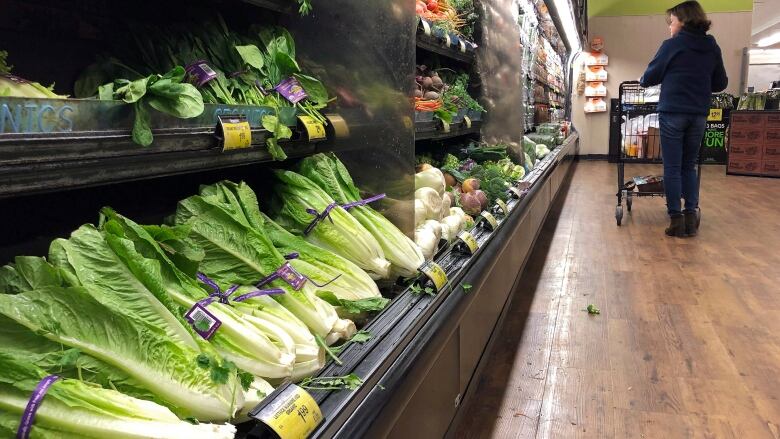New Brunswick joins provinces affected by E. coli linked to romaine lettuce
19 cases have been reported in Ontario, Quebec and New Brunswick

A case of E. colithought to be linked to romaine lettuce has been confirmed in New Brunswick, making it the third province affected by an outbreak that has now made 19 people in Canada ill.
"New Brunswickers should avoid eating romaine lettuce and salad mixes containing romaine lettuce until more is known about the outbreak and the cause of contamination," said Dr. Jennifer Russell, the province's chief medical officer of health, in a news release issued Wednesday.
The Public Health Agency of Canada, which on Tuesday warned people not to eat romaine lettuce in Ontario and Quebec, is aware of the case in New Brunswick, spokesperson Anna Maddisontold CBCNews in an email, and is updating its national advisory.
The strain of E. colicontaminating the lettuce is the same that caused asimilar outbreaklast year, prompting questions about why the federal government has stopped short of issuing a mandatory recall.
"Basically it's lightning striking twice," said Prof. Keith Warriner, a microbiologist specializing in food safety at the University of Guelph, noting that the strain,E.coliO157, is particularly "virulent," meaning it makes people sick more often than other forms of the bacteria.
"It's worrying that it's the same strain [of E.colias last year], which basically means it's the same source.And that means they never solved the problem," he said.

In addition to the New Brunswick case, there have been 15 confirmed cases of the bacterial infection in Quebec and three in Ontario since mid-October, according tothePublic Health Agency of Canada.
Although no deaths have been reported, at least six people have beenhospitalized.
South of the border, the outbreak has also made32 people sick in 11 states, according to the U.S. Food and Drug Administration(FDA).
Health officials were never able to conclusively determine exactly what caused romaine lettuce to become contaminated with E. coli O157in Canada and the U.S. in November and December 2017. Because they weren't able to pinpoint a specific supplier of lettuce, they didn't issue a recall.
That was a"point of frustration" then, said Warriner, because it left retailers and restaurants uncertain about whether to pull romaine lettuce from their shelves something many ended up doing anyway.
Regulators are "always a bit hesitant to press that recall button," hesaid, because they don't want to risk singling out the wrong company or supplier, which can be financially devastating to that particular business or industry.
Between farm field and store shelf, lettuce passes through "many hands" and processes, he said, making it very difficult to identifythe source of E. colicontamination.
When asked by CBCNews why a recall hasn't been issued, a spokesperson for the Canadian Food Inspection Agency (CFIA) said the agency was leading an investigation into the possible source of the outbreak.
"If a specific brand and/or source of romaine lettuce or other product is identified in the investigation, CFIA will take appropriate action. If a food recall warning is issued, CFIA would verify that the food industry and retailers remove the recalled products from the marketplace," said Lisa Murphy in an email on Wednesday.
"Neither the Canadian or American food safety investigation have been able to identify a specific product of concern in the Canadian or American marketplace.All products tested as part of the investigation have been negative so far."
ButWarrinerbelieves a "blanket" recall making it mandatory for all stores and restaurants to stop selling or servingromaine lettuce, regardless of the source is warranted.
"It's the same playbook [as last year].They seem to be saying, 'We're not going to recall it, but we advise you not to eat it.' Which I think is a bad thing because it gives confusion."
FDA Commissioner Scott Gottliebalso said hisagency didn't have enough information to request suppliers issue a recall, but he said supermarkets and restaurants should withdraw romaine products until the contamination can be identified.
BREAKING: Thread - #FDA is investigating a multistate #outbreak of E. coli illnesses linked to romaine lettuce. While we dont have enough traceback information to request a recall from specific suppliers, were working now to prevent unnecessary foodborne illness. pic.twitter.com/Wsd6buCzCT
—@SGottliebFDAMajor grocery chains in Canada including LoblawCompanies Limited,Sobeys Inc. and Metro Inc. announced Wednesday they were voluntarily removing romaine lettuce products from their stores across the country.
In a news release posted on its website, Loblawalso said its stores would provide "a full refund" if customers returned the products.
Most people suffering from E. coliinfections"recover completely on their own," the Public Health Agency of Canada said.Those most at risk for developingcomplications are pregnant women, people with weakened immune systems, young children and seniors.
Complications can be life-threatening, including kidney failure.
Some people can be infected with E.coliwithout symptoms but still spread the infection to others, the agency said.
Symptoms of E. coli illness include nausea, vomiting, headache, fever, severe stomach cramps and watery or bloody diarrhea. People usually get better within five to 10 days and there is no "real treatment" apart from staying hydrated.
Antibiotics should not be used in treating E. coliO157 bacterial infections, said Dr. Isaac Bogoch, an infectious disease specialist at Toronto General Hospital.
"They can actually do more harm than good," said Bogoch. "If antibiotics are used with this particular type of infection, what can happen is it can trigger a pretty nasty cascade within the body that can result inkidney failure and kidney damage."
E. colibacteria are naturally found in the intestines of farm animals. Contamination of vegetables and fruit can occur when they come in contact with animal feces. Most forms of the bacteria are harmless.
What people should do
Under normal circumstances, health officials often advise people to throw away the outer leaves of romaine lettuce and wash the rest.But right now, with E.coliO157around, people shouldn't take any risks, Warrinersaid, advising them to get rid of any romaine lettuce they have.It only takes a small number of the bacteria's cells to cause illness, so handling contaminated lettuce can spread infection, he said.
The U.S. Centers for Disease Control and Prevention advises people to "wash and sanitize drawers or shelves in refrigerators where romaine was stored" and to see their health-care provider and notify public health authorities if they have symptoms of an E. coliinfection.
See a doctor if you develop symptoms of E. coli infection. People with E. coli infections usually get sick with bloody diarrhea and stomach cramps 3-4 days after eating food contaminated with the germ. Learn more. https://t.co/kGAt5UM5tO
—@CDCgovWith files from the CBC's Kelly Crowe and The Associated Press













_(720p).jpg)


 OFFICIAL HD MUSIC VIDEO.jpg)
.jpg)



























































































